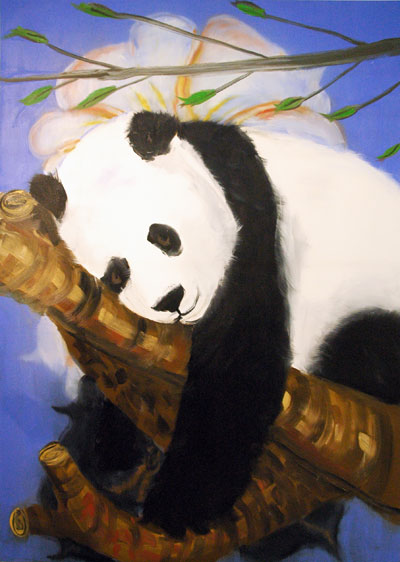Culture: March 2008 Archives
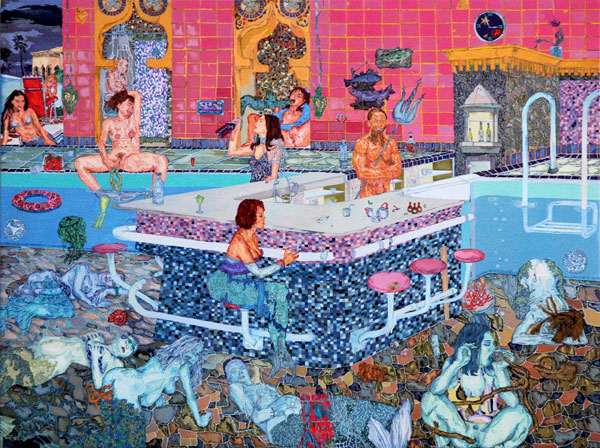
Kelli Williams Wet Bar 2007 oil on panel 26" x 12"
Kelli Williams visits a palace in Baghdad, in this exquisite little painting shown by Leo Koenig at Armory
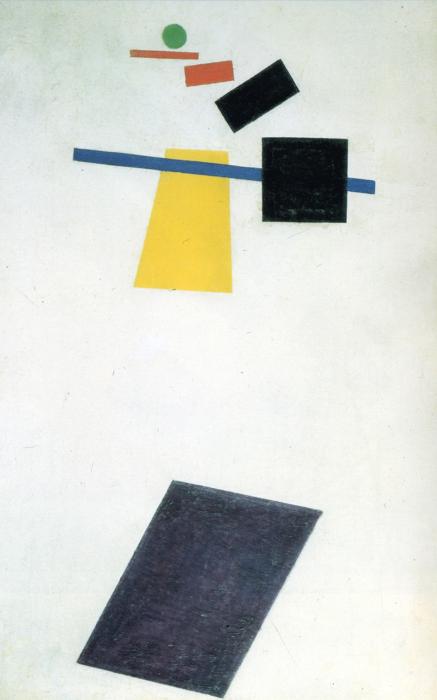
Kasimir Malevich Soccer Player in the Fourth Dimension (1915)
I'm a really bad PR person. Until now I'd neglected to tell people about a forum on video art which is connected to "WHITE BOX SPEAKS", and now there's only one day left of a full schedule of events which began seven days ago. I'm obviously bad with the fourth dimension, but I'm doubly bad this time because I was actually invited to the last presentation. It starts tomorrow (Sunday the 30th) at noon and I haven't written about it.
The forum of which I'm to be a small part is "CURATING TIME-BASED ART: THE FOURTH DIMENSION", but I think the discussion will address more than the concerns of curators alone. The event was organized by VideoArtWorld. It's at White Box, which is located 525 West 26 Street, between Tenth and Eleventh Avenues. The moderator will be Blanca de la Torre and the participants are Amanda McDonald Crowley, Natalie Angles, James Wagner, Eric Shiner, Marco Antonini, Heide Hatry, Micaela Giovannotti, Raphaele Shirley and Michelle Handelman.
Following the discussion, there will be a terrific video screening program, also at White Box, starting at 2pm. Go to VideoArtWorld for the complete afternoon program.
[image from wikimedia]
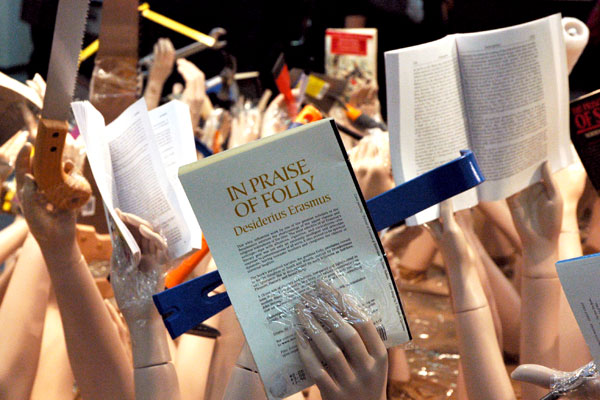
Thomas Hirschhorn Tool Table 2007 2 wood planks: 98.5" x 118" each; 12 trestles: 39.25" x 31.5" x 31.5" each; total of all elements: 236.25" x 98.5" x 39.25" [detail of installation]
I haven't had a chance yet to post anything about Armory or any of the other New York art fairs which are distracting so many of us this week. But I did want to give some indication that life goes on somewhere behind this site, and I thought my detail shot of Thomas Hirschhorn's installation in the Armory stall of Berlin's Arndt & Partner might be an appropriate comment with which to start. Maybe you have to have been there, but the awesome ambivalence of Erasmus's essay, Hirschhorn's reference, and my own use of both here works for me.
I once had a crush on Erasmus (there was a lot to like, and I thought he was hot), so I read the whole darn thing in Catholic prep school.
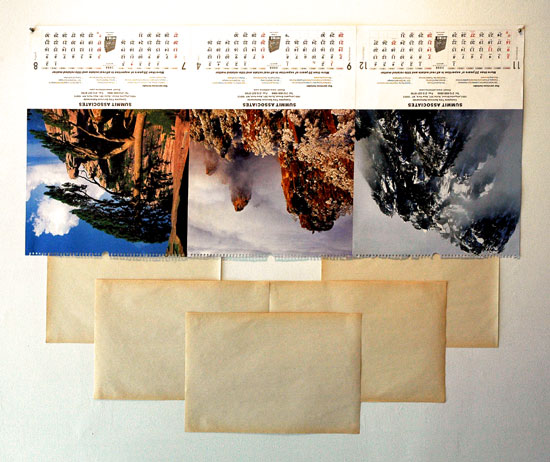
Ian Pedigo Summit Associates 2008 newsprint, calendar pages 42" x 50.5" [installation view]
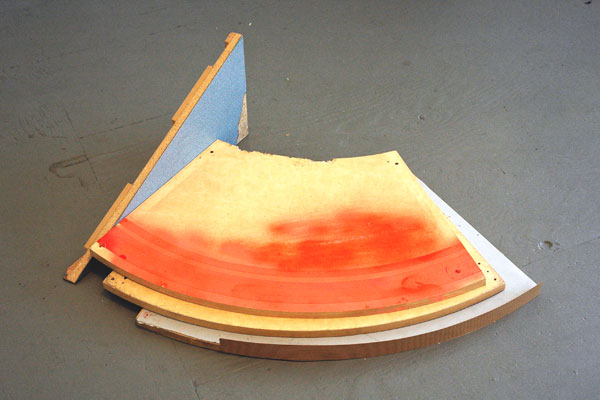
Ian Pedigo Already No Longer the Same 2008 wood, laminate, tape, paint, PVC sheet 11.5" x 25.5" x 37" [installation view]
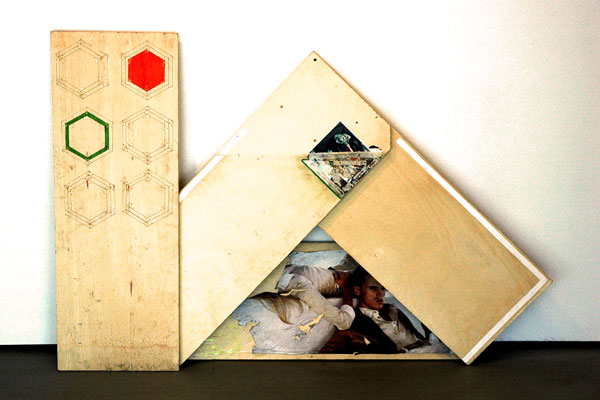
Ian Pedigo Saying it was Disproportionate 2008 wood, magazine clipping, tape, vinyl poster, permanent marker 42.5" x 63.5" [installation view]
Ian Pedigo in "Titanium Pro" at Klaus von Nichtssagend
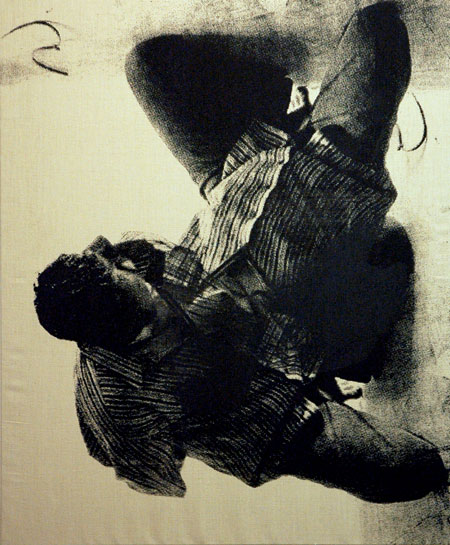
Scott Hug Hostage 8 2008 silkscreen on linen 51" x 42"
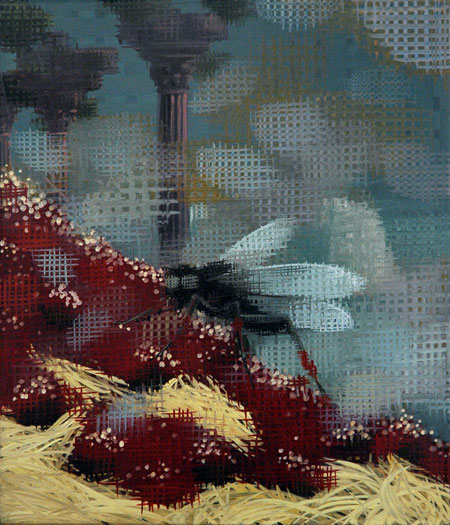
Michael Wetzel The FLy I 2007 oil and egg tempera on canvas 16" x 13"
"A New High In Getting Low" at John Connelly Presents

Dave Miko Empty Building 13 oil on aluminum panels 48" x 151"
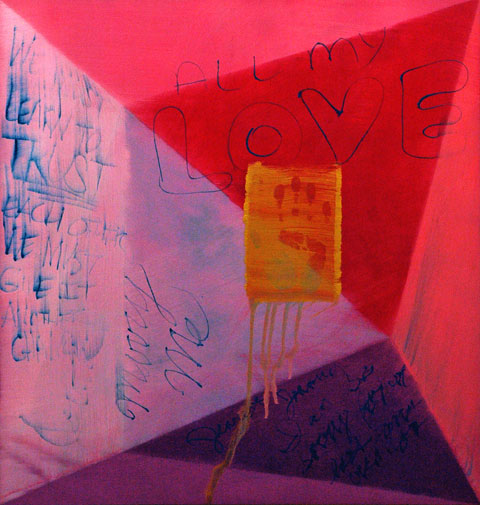
Dave Miko Love Letters 2007 oil on aluminum 32" x 30"
Dave Miko at Wallspace
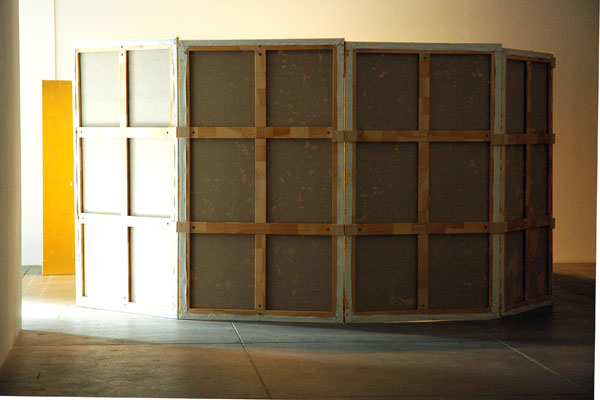
Jim Hodges and still this 2005-2008 23.5K and 24K gold with Beva on gessoed linen in 10 parts 200" x 185" x 89" [installation view of exterior]

[large detail view of interior]
Jim Hodges at CRG
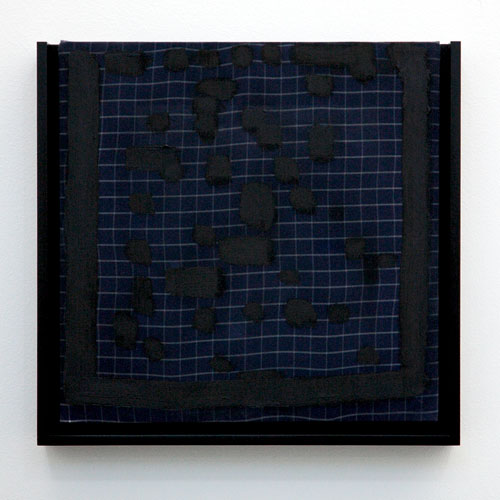
Matt Connors untitled 2008 oil on printed cotton with painted wood 10.5" x 11" [installation view]
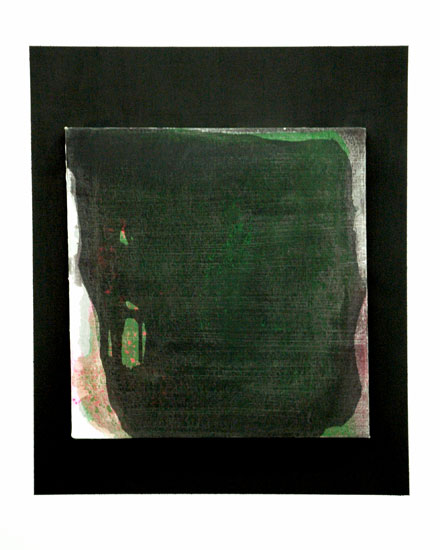
Matt Connors Pissed Print 2008 oil on printed linen on painted wall 26" x 21.5" [installation view, showing white gallery wall]
Matt Connors, "Enjambment", at CANADA
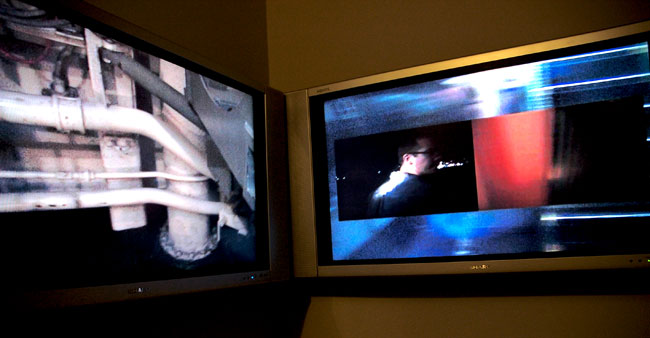
Lutz Bacher Sub 2001-2007 video [installation view]

Lutz Bacher Men at War 1975 two unique sets of nine black & white fiber prints, 15" x 12" each [detail of installation]
[I'm going to be posting a number of entries on shows I like which will include images but, because of the distractions of this week's art fairs, no significant text]
Lutz Bacher at Taxter & Spengermann

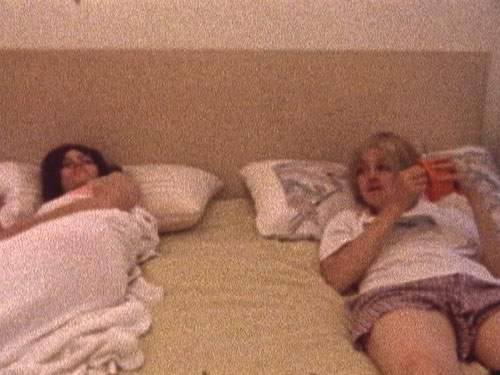
Shannon Plumb Together 2008 single-channel video [large details of two stills, the first from the segment "Tuesday", the second from "Saturday"]
Barry and I were both laughing out loud in the upstairs gallery at Sara Meltzer. It may even have been what brought Sara out of her office. It was only when I was home, hours later that I thought about how rare that kind of reaction to a gallery show really is. So, does that make the work suspect as art? Not as far as I'm concerned, and particularly in the case of Shannon Plumb's aggressively lo-fi videos, which have charmed - and provoked - me for years.
"Together", a 24-minute video shot on Super 8, is composed of seven films each describing the ordinary activities which make up a day in the week of a cohabitating male-female couple, He and She, who were inspired by her grandparents. Both are played in inspiring performances by the artist.
The gallery setting was an old Zenith console TV in front of two comfortable but undistinguished upholstered armchairs (one displaying a series of notches almost certainly carved by He), and almost totally-unremarkable carpet. We could have stayed for hours, or at least long enough to meet the two stars, but it seems they have retired from show business. The costumes, hair and mustache glue with which had initialed their colorfully-disparate performances were now inside two sealed glass jars resting on plinths arranged over to the side.
[images from Sara Meltzer Gallery]
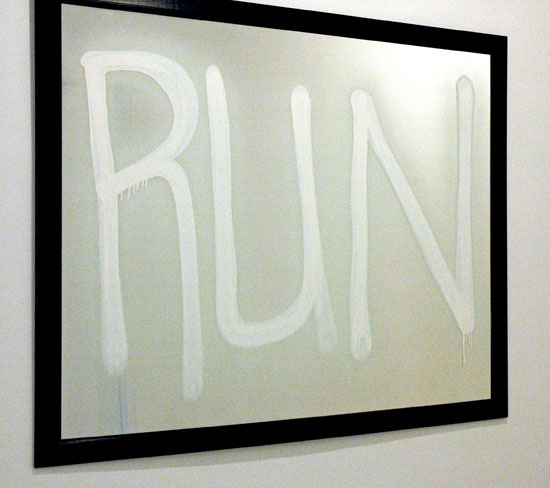
Rashid Johnson Run 2008 mirror with spray paint 53" x 65" (including frame) [installation view]
Almost the first piece the visitor sees is a large, five foot mirror covered with the paint-sprayed word, "RUN". Perhaps a tough auspice for an artist's first New York solo appearance, but it definitely shouldn't be taken as an exhortation. Rashid Johnson's installation at Nicole Klagsbrun, "The Dead Lecturer", is one very fine show, its photographs and sculptures culled from, as the press release tells us:"a mythic secret society of African-American intelligentsia within a metaphysical landscape removed from time and history."
There are some very good images on the gallery's site, but a visit and the naked eye would do much better.
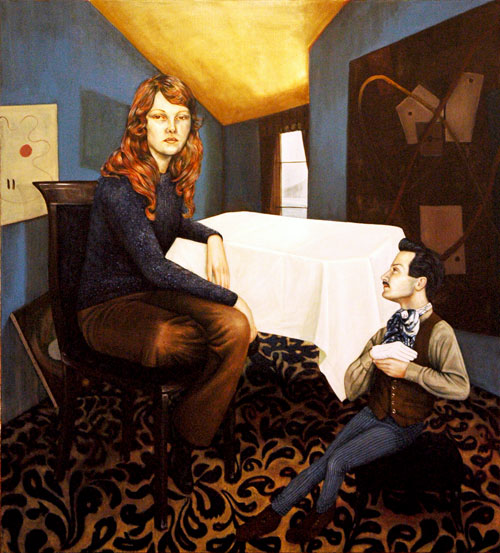
Norbert Witzgall Sophie Matt 2007 oil on canvas 57.5" x 63"
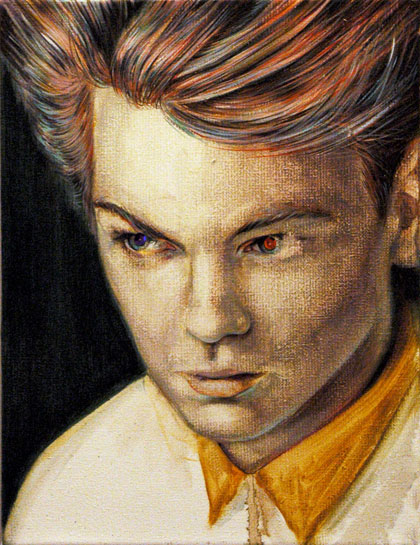
Norbert Witzgall Icy 2008 oil on board, paillettes 9.5" x 11.75"
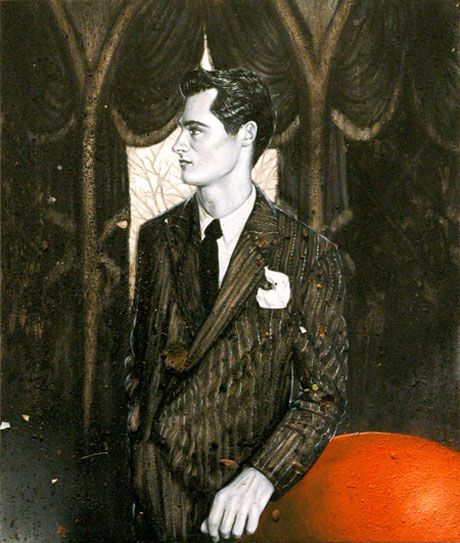
Norbert Witzgall Isi Baisia 2008 oil on board, dirt 12.5" x 15"
Venetia Kapernekas is looking more and more interesting these days. The current show, "wir", is devoted to some hauntingly-beautiful paintings by Norbert Witzgall.
There doesn't seem to be any easy way to describe their inspiration, but we get some clues in the large canvas (all of the other, smaller works are on board). In "Sophie Matt" the odd planes of a room which is (almost) dominated by a portrait of the artist Sophie-Therese Trenka-Dalton are hung with Picabia-inspired paintings. The inclusion of a dwarfish smaller figure, the instinctively-whimsical and seriously-inventive young artist Matthew Lutz-Kinoy, suggests either a renaissance devotional painting or the hermetic environment of the seventeenth-century Spanish court. Most of these odd and somewhat faded portraits of family members, friends, the famous and the forgotten, include a medium in addition to paint. Sequins, dirt, stars or pressed flowers, remove them even further from the convention which developed the genre over the centuries.
The gallery furnishes a useful list which documents the artist's image sources. "Icy" is a headshot of River Phoenix, "Isi Baisia" is a fashion photograph by George Platt Lynes of someone named Whitney.
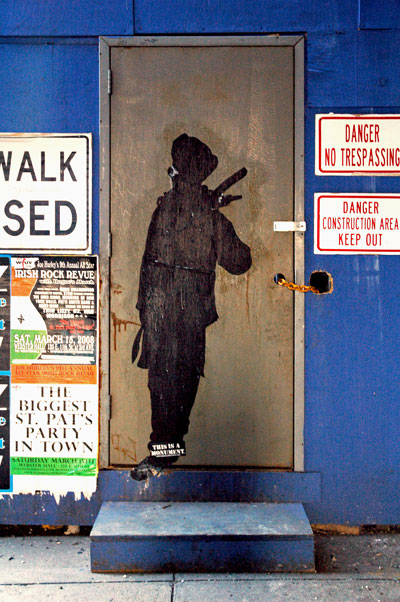
"this is a monument"
This figure darkens the doorway of a temporary construction shed on the south side of West 26th Street.
When it comes to something like the Whitney Biennial, or for that matter the siren of any large display of contemporary art, whether a museum survey, an art fair or even a small-budget benefit, I look forward to seeing stuff by artists I haven't heard of before but I'm also excited to see emerging artists I've managed to scope out already. If I liked the work there's nothing more exciting than seeing the artist get greater recognition and a broader audience.
While the latest Whitney Biennial makes me happy on both accounts, there's one area in which it may disappoint even some of its most loyal fans: There is some surprisingly-not-so-exciting new work by familiar and honorable names included in the 2008 survey presumably because of their continued importance to younger colleagues and to the contemporary scene generally.
I'm thinking of the work of John Baldessari and Sherrie Levine, or at least her sculptures, and I was disappointed by the work with which Mary Heilmann and James Welling were represented. I'll add quickly add that Matt Mullican's work looked great, even if I can't explain it.
What will follow all these paragraphs is a list of some of my enthusiasms for work by the show's less-established artists. I'll admit there were some rough spots on Madison and Park Avenue last Wednesday afternoon (I just don't get Kembra Pfahler or Seth Price, for instance), but it was great fun making the rounds.
Someone should write about the impact on curated events like the Biennial of "art shows" like Armory, Basel and the dozens of newer ventures which drag gallerists, artists, curators and collectors to more and more venues all over the planet. Maybe the evaluation will become easier if they begin to lose viability, as many are predicting. In any event, perhaps it's the hoped-for effect of the "cure" in the curator which brings us back to the Whitney's signature venture every two years.
I've only been to the press preview so far, and that visit was limited to but a few hours (not enough time, even for an exhibition with fewer artists than usual, especially since there is so much performance art included this year). This checklist is therefore somewhat provisional. I look forward to another visit - and a revisit to work which didn't register with me the first time around. Also, to be fair, these choices represent a limited number of somewhat accidental marriages between picks and my ability to get decent images with my camera.
One more thought: Many of the pieces which have been selected, or in fact commissioned, by the curators are pretty overtly political, something which even a few years ago visitors and critics would have found, literally, "remarkable". The world has indeed changed, certainly for the worse, but the fact that more and more people understand that may be attributed not least to the many artists who actively pursued truth all along.
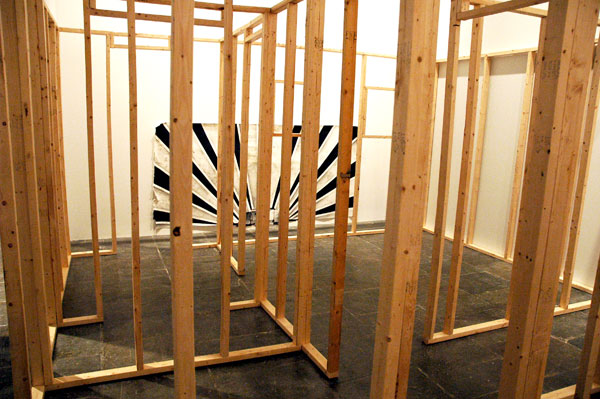
William Cordova's open, labyrinthian construction of wooden studs, "The House That Frank Lloyd Wright Built for Fred Hampton and Mark Clark", is an historical and political document; the work seen on the far wall is "Ollantaytambo (for F. CLearwater, L. Lamont & Bunchy Carter)"

Heather Rowe's "Something crossed the mind (embellished three times)" defends its Whitney-commissioned territory while literally reflecting its museum environment

Matt Mullican shows some "ellipses and balls", and some other stuff; that's all I know right now
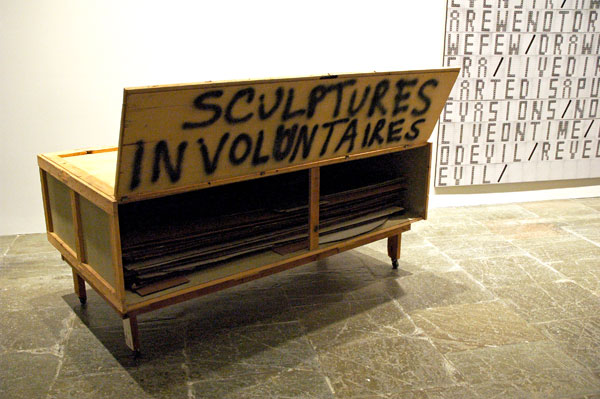
Shannon Ebner's, characteristically assembled from language, here includes "Involuntary Sculpture" from 2006 in the foreground, and this year's "STRIKE", a detail of which is seen to the right
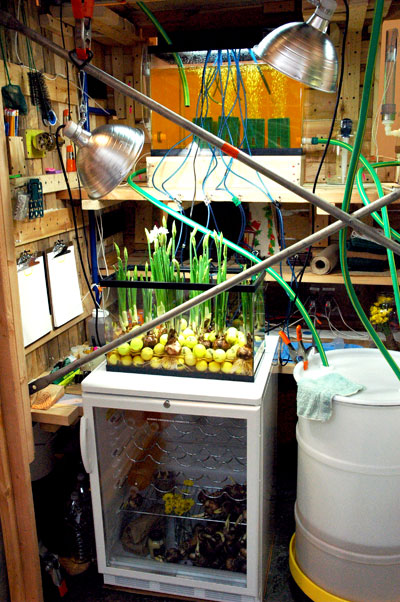
Phoebe Washburn employs golf balls, Gatorade, a wine refrigerator, and whatnot in order to sustain a ecosystem for flowers, "While Enhancing a Diminishing Deep Down Thirst, the Juice Broke Loose (the Birth of a Soda Shop)"
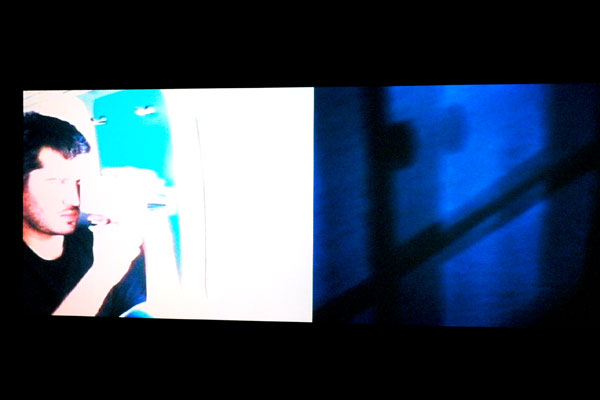
Amy Granat and Drew Heitzler, inspired by Goethe's Werther, document a road trip in projection stills from "T.S.O.Y.W."
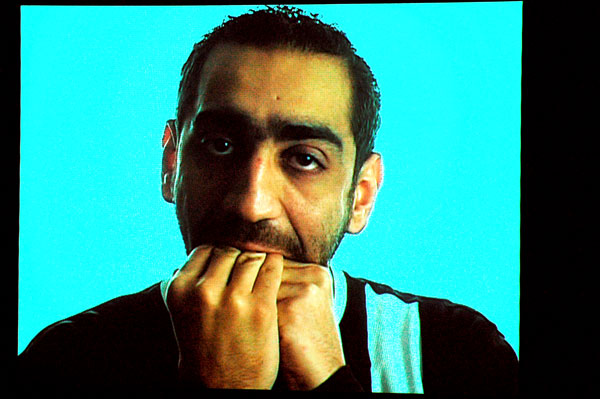
Julia Meltzer, David Thorne and Rami Farah collaborated on "not a matter of if but when: brief records of a time when expectations were repeatedly raised and lowered and people grew exhausted from never knowing if the moment was at hand or was still to come"
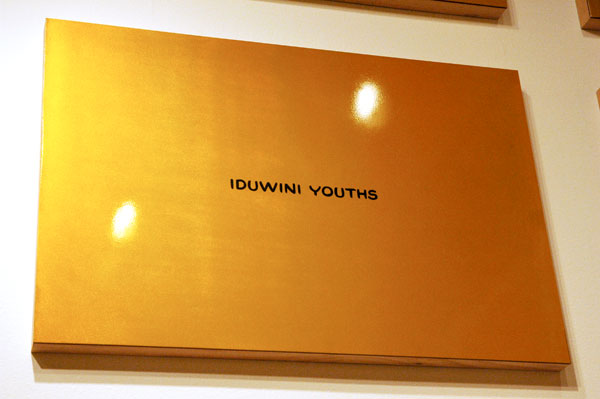
Daniel Joseph Martinez's installation suggests a golden ossuary, but the bones which sustain the many worldwide terrorist organizations that are the painted subjects of "Divine Violence" are not at rest
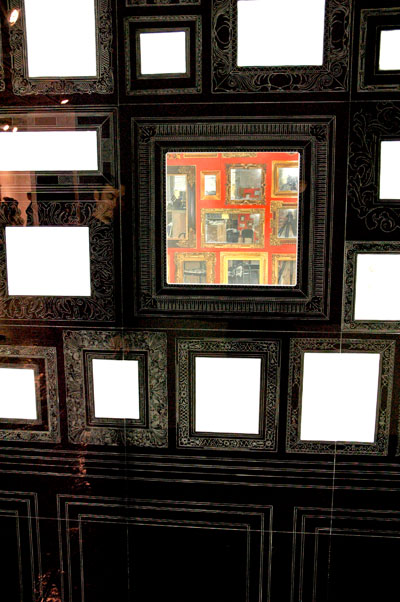
Ellen Harvey has installed an entire environment, "Museum of Failure: Collection of Impossible Subjects & Invisible Self-Portrait in my Studio", in a room of her own at the Whitney

Walead Beshty's gorgeous series of photographs, "Tschaikowskistrasse 17 in multiple exposures (LAXFRATHF/TXLCPHSEALAX) March 27-April 3, 2006", documents an abandoned embassy to a state which no longer exists representing a government which no longer exists
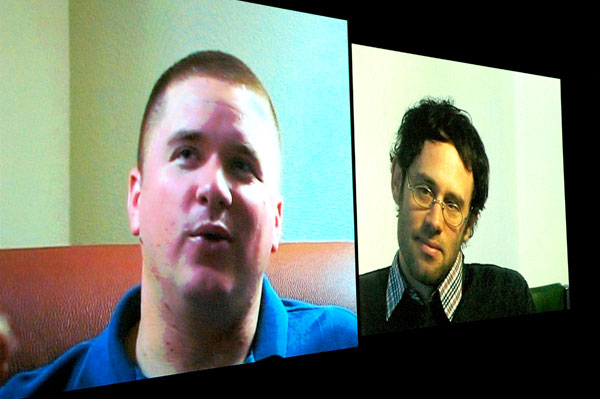
Omer Fast's "The Casting" conflates the perversity and ordinariness of domestic and military violence in a four-channel video which employs actors and a script

Cheyney Thompson's paintings, like all of his work, are like nothing else around; there were three large dark (virtually unphotographable) canvases surrounding this single smaller and lighter painting.
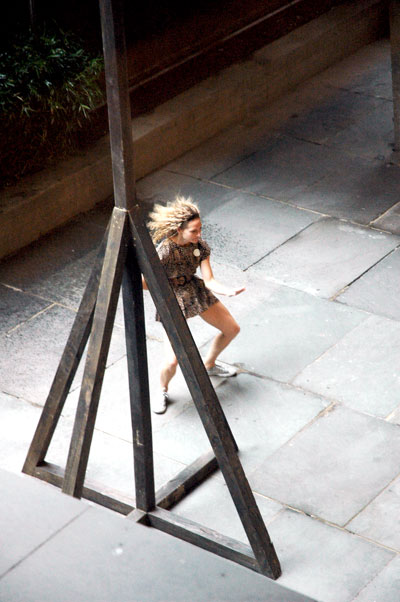
Flora Wiegman, who performed solo throughout the Whitney on Wednesday, dancing [see Barry's video] the role of various creatures protected by Fritz Haeg's sculptural initiative, is seen here below the bat house at the bottom of the Museum's broad moat
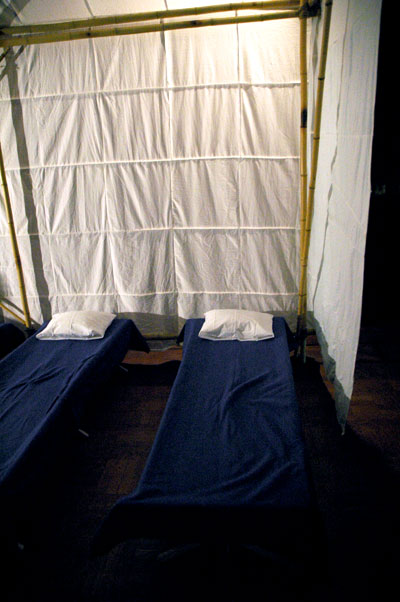
DJ Olive installed a campsite and sound project inside the Seventh Avenue Armory, on the second floor and the mezzanine above
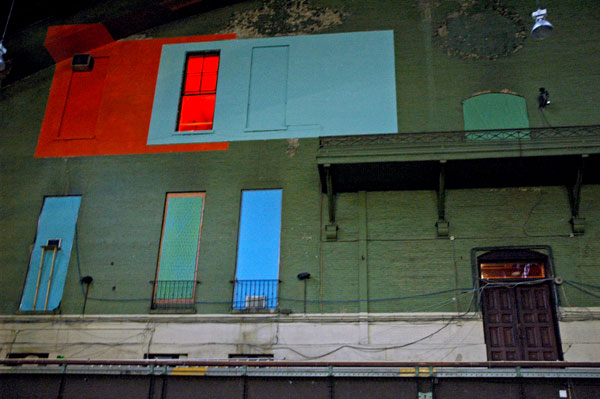
Lisa Sigal re-imagined parts of the east wall of the Administration Building inside the Drill Hall
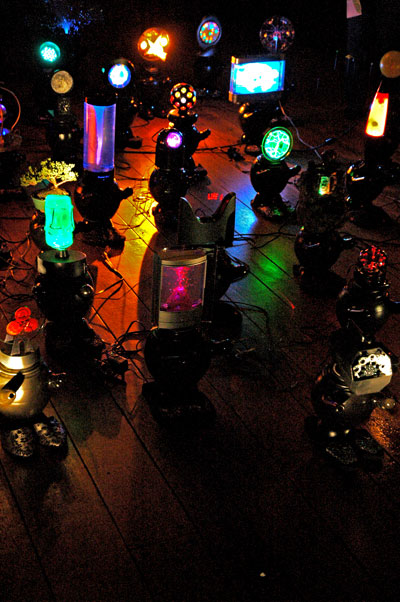
Olaf Breuning assembled a colorful, animated and whimsical platoon of teapot-based electric robots, "The Army", and installed it on the second floor of the Armory
I didn't take notes, so I'm sure I've forgotten a number of people, but some of the artists responsible for installations I did not record digitally but which I really liked include, : Bozidar Brazda, Harry Dodge and Stanya Kahn, Garder Eide Einarsson, Roe Etheridge, Rashawn Griffin, Alice Könitz, Louise Lawler, Jason Rhoades and Bert Rodriguez.
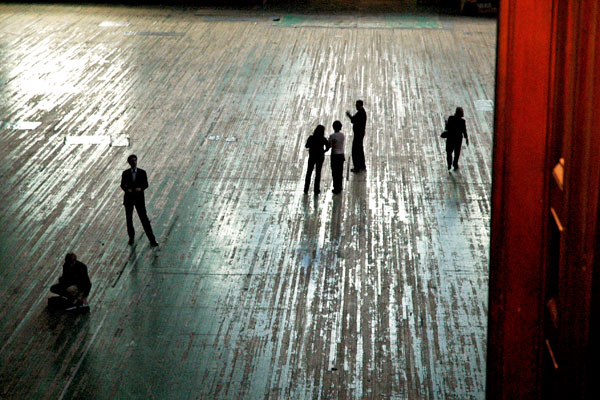
Drill Hall floor of the Armory
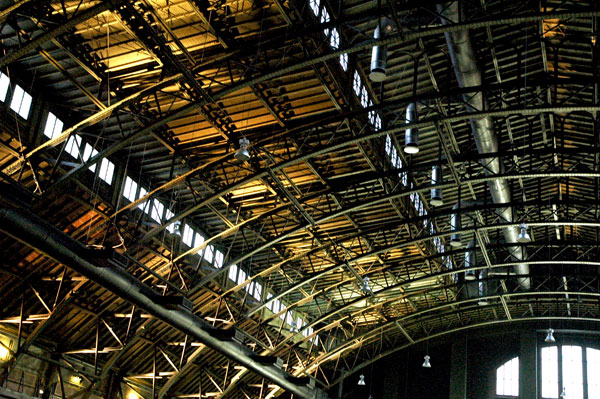
Drill Hall vault of the Armory
We were at the press preview for the Whitney Biennial this afternoon. This year the venue has been expanded to include the Seventh Regiment Armory, in whose extravagant nineteenth-century precincts many of the exhibition's performance art elements (including some interactive experiences scheduled throughout the next month) have been assigned high-ceilinged rooms and closets.
But I as I wrote last week I always have a lot of trouble resisting the aesthetic and historical seductions of architecture like this even when there's exciting contemporary art to be seen. So here I am writing a post preceding my observations of this year's Biennial with a couple images of the Armory which shelters some of the installations, and to show that I'm not indifferent to the charms of Marcel Breuer's own hall, I'm including a view of his lobby ceiling, one of my favorite details in the Whitney itself.
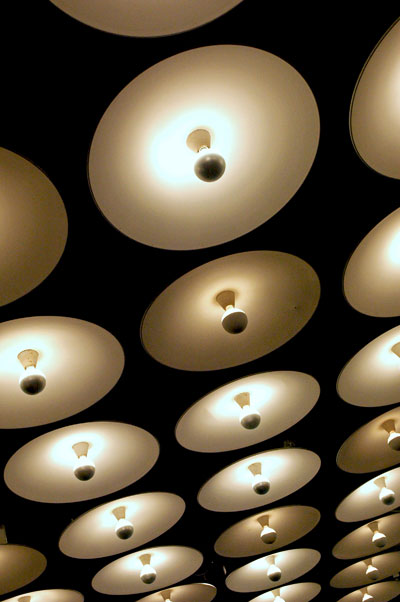
lobby ceiling of the Whitney

"Certainly the prestige of the office of president must be seriously compromised if a woman has a serious shot at it."
I would add "or a black man" to that conditional clause, but the subject of the article from which this quote was pulled is specifically that of the place of women in American society. The sentence is inserted as a parenthetical reality check inside the penultimate paragraph of Leslie Camhi's Village Voice review of "Wack! Art and the Feminist Revolution" at PS 1. She alludes to the current state of our national political life with this reminder of both how far we have come and how close we still remain to the more benighted environment of the 60's and 70's which inspired the feminist revolution:
Just how far we've traveled since those times might be measured by the fact that the female contender for the Democratic presidential nomination is perceived as the establishment candidate. (Certainly the prestige of the office of president must be seriously compromised if a woman has a serious shot at it.) But some things almost never change: It's nearly impossible, for example, to imagine this show being staged across the river, at P.S. 1's Manhattan affiliate, the Museum of Modern Art.Instead, the artists of "Wack!" remain in the schoolhouse. But their contemporaries might well take a lesson from them.
[Presidential chart image by Automatic Preference whitosphere blog via Francis L. Holland]
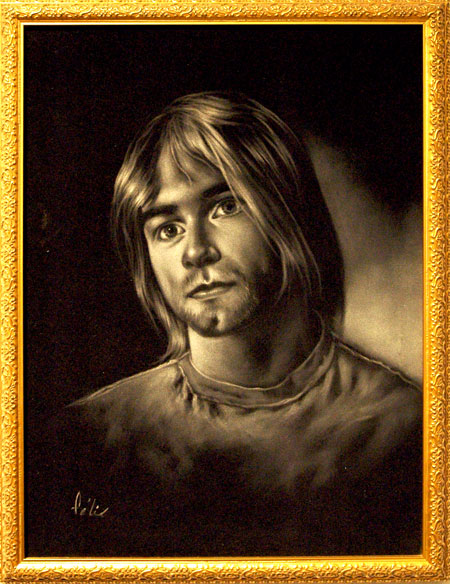
portrait of Kurt Cobain, by an anonymous artist, from a collection of paintings on velvet
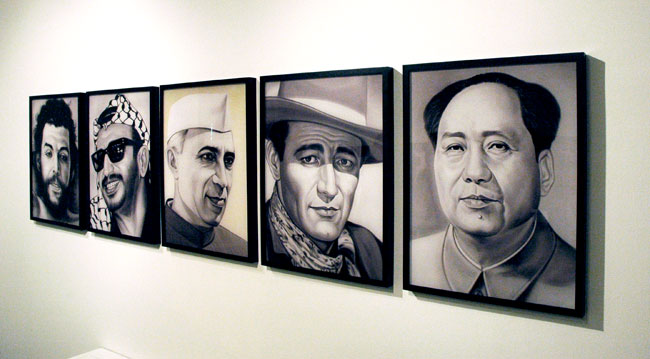
Yasser Aggour's photographs of portraits commissioned of Cairo sign painters
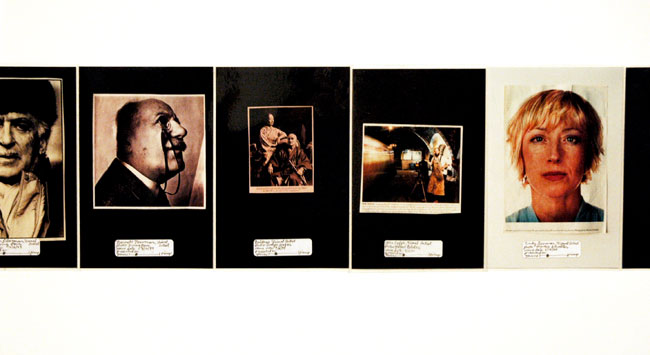
detail of a section of Jennifer Dalton's "What Does an Artist Look Like?" captured from three years of The New Yorker
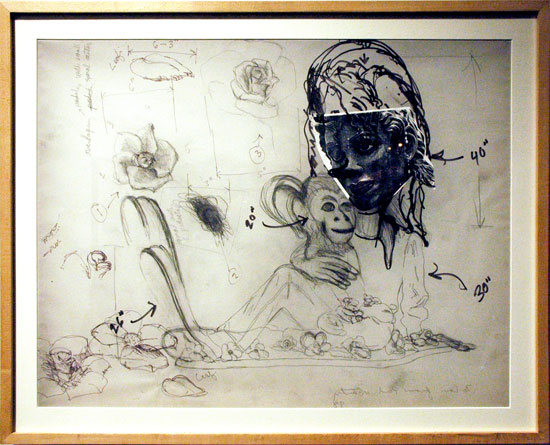
Paul McCarthy's drawing referencing Michael Jackson and Bubbles through Jeff Koons
Portraiture isn't what it used to be; or is it? Maybe it's just the times; the times, they just aren't what they used to be either.
SoHo's Carriage Trade gallery opened its exhibition, "The Cult of Personality, Portraits and Mass Culture", this past Thursday. An auspicious inaugural show, it uses portraiture as a means to examine the way in which our myths are assembled and deconstructed, specifically marking the similarity between the the myths which create, sustain and dim celebrities (and the products they sell) and those which generate, underpin and erode governments (and the policies they pursue).
An excerpt from the press release elaborates:
The process of crafting present-day myths to be served up for the purpose of turning the news into entertainment requires some belief in charismatic personalities. While the concept of a cult of personality is most often associated with autocratic leaders who use mass media to develop and sustain their popularity in an undemocratic state, the sphere of influence enjoyed by the media within a democratic system, and recent cases of its manipulation by government, suggest that this concept is ready for an expanded definition.I was totally smitten with the one piece I couldn't find on the gallery list. It's the black and white painting on velvet to the left just before you reach the desk. I had no idea who had created it (and as it turns out, nobody knows, including artist and gallery director Peter Scott), but maybe I was one of the few people in the room who had no idea whose portrait it was. Okay, Scott told me it represents Kurt Cobain, but how was I to know Cobain was beautiful even as a child? The work itself may or may not really be a part of the show. Although it's signed "Felix", it's by an artist whose name is apparently unknown even to its owner, WFMU's Station Manager Ken Freedman. It was purchased in Tijuana, from the painter.In adopting the genre of portraiture, a form associated with traditional identity construction which focuses on the relative psychological interest of the subject, The Cult of Personality, Portraits and Mass Culture attempts to locate the manner in which the development of an identity for mass consumption adopts the traditional viewer/subject relationship, often with the expectation that viewer will lose themselves in the protectiveness or superiority of the subject while finding momentary fulfillment in a distraction from what they are meant to feel that they lack.
. . . .
In the run up to an election which is mercifully overshadowing our current leaders long, slow decline in popularity, the mechanisms through which personality can trump reason in the public sphere might be worth revisiting, if only as a reminder of the very real consequences of allowing fictions to displace facts.
Popular commercial art, whether produced on commissioned or speculation, is a concept and a subject worthy of a serious book itself, and my apologies to the responsible parties if I'm overlooking the effort(s) of anybody who's already gone there.
Scott has put on a wonderful show. There are a relatively modest number of works involved, but this provocative and compelling curatorial project enjoys the additional interest which their broad diversity of medium, sophistication and approach provides.
The artists in the show whose work is not shown in the images above are Ligarno/Reese, Karen Yama, Vitaly Komar, Sherrie Levine, Muntadas and Reese, Julia Wachtel and Bill Owens.
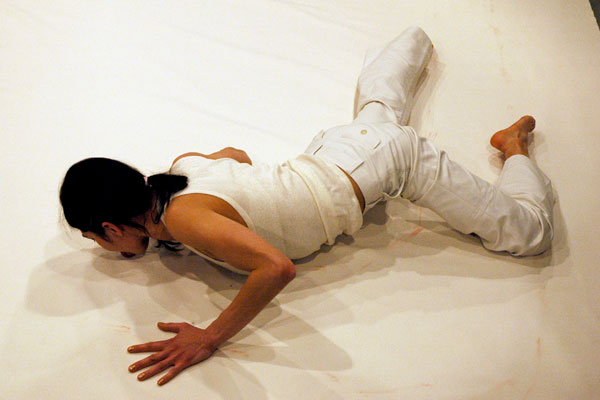
Lilibeth Cuenca Rasmussen's re-enactment of "Licked Room" 2000 by Ene-Liis Semper
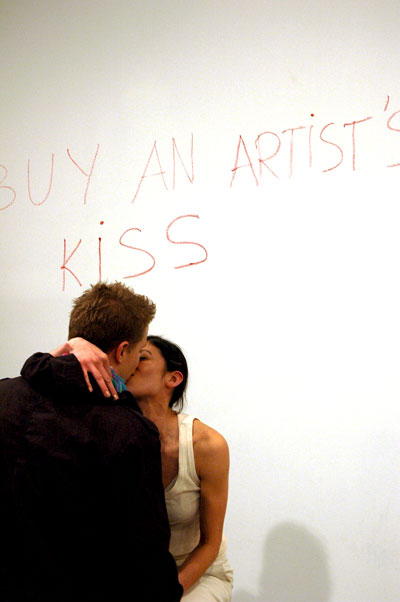
Lilibeth Cuenca Rasmussen's re-enactment of "The Artist's Kiss [Le Baiser De L'artiste]" (1977) by Orlan
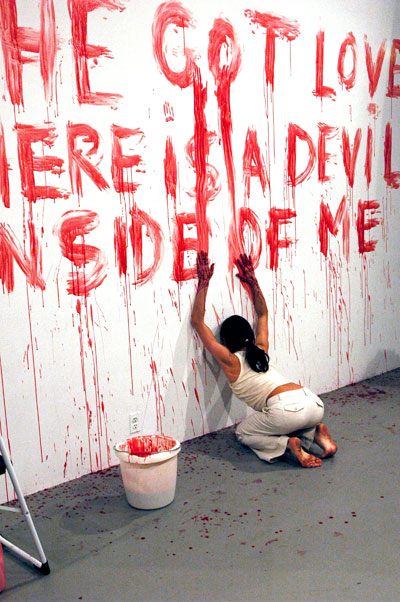
Lilibeth Cuenca Rasmussen's re-enactment of "Blood Signs & Body Tracks" (1974) by Ana Mendieta
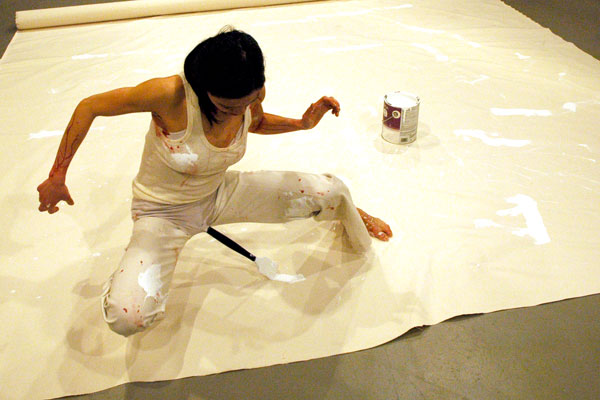
Lilibeth Cuenca Rasmussen's re-enactment of "Vaginal Painting" (1965) by Shigeko Kubota
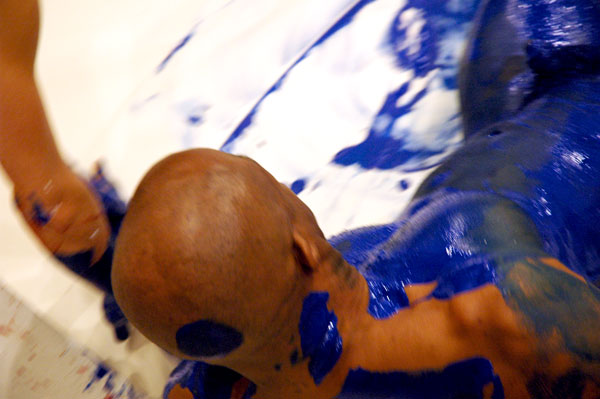
Lilibeth Cuenca Rasmussen's re-enactment of "Anthropometries of the Blue Period" (1960) by Yves Klein
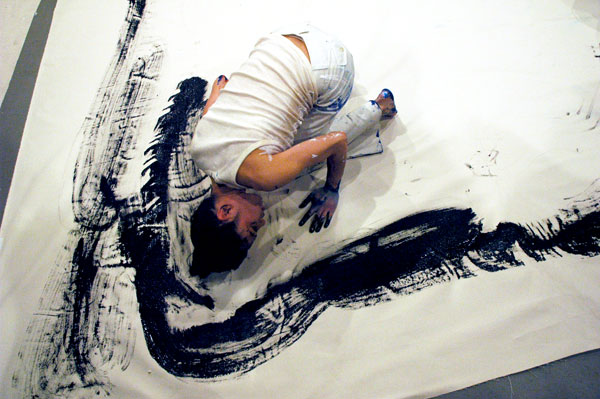
Lilibeth Cuenca Rasmussen's re-enactment of "Loving Care" (1992-1996) by Janine Antoni
Lilibeth Cuenca Rasmussen performed fourteen historical "re-enactments" (actually, thirteen plus the artist's own contemporary "The Artists's Song") at Renwick Gallery Thursday night, but for those of us fortunate enough to crowd into this west SoHo space for "A Void", almost all of whom must have missed the legendary originals, the performances may have felt pretty much like the enactments, created over the half century beginning in 1958, felt to earlier audiences - or not. In any case, now they have become acts for our own age, if only because this time we were watching fourteen of them follow immediately upon each other within the space of a single evening.
I loved it, enough to hardly notice that I was standing mostly in one place at an opening for almost three hours (with a quick break early on for another gallery's reception, a big treat itself, but one which did not offer this kind of live, one-off theater).
Much of what I've seen of Rasmussen's creative output references art, artists and the art world, but the combination of seriousness and wit in her provocative performances is distinctly her own.
Everyone's experience of the evening must have been pretty personal, but the outline of the artist's concept for this, her first solo show in the U.S., is covered very well in this excerpt from the press release:
"A Void" investigates the identity of an artist and questions the authenticity of the art work and the history of art. Performance art has been very radical in its transgressions and has expanded the categories of art. The authenticity of performance art is related to the here-and-now experience. When the performance is over, it can only be experienced through documentation far from the original experience. Even if it is performed again, it will be very different from the original experience, dependent on the artist, the audience, time and context.The remaining sections not represented in the images I include here were inspired by Piero Manzoni, Rirkrit Tiravinija, Claude Wampler, William Wegman, Yoko Ono and Nam June Paik. Did I say the performances were terrific? Also, I can't wait to go back to see what the gallery, which started out at 6pm as an empty white box, "a void", will look like during the remainder of the exhibition, once the water and other debris have been cleared away. There will be the performance documentation, of course, but I'm guessing that at least some of the canvases created Thursday night might play a role as well.Lilibeth Cuenca Rasmussen re-enacts other artists' performances in her own way. The point of departure is identical, but the experience will be completely different. The historical re-enactments will follow each other without precedent announcement as one long performance. They will be documented and shown on video after the opening. Traces of the performances will also be present as drawings and photographs.
For more, including a video capture of one of the re-enactments, see Bloggy.
